| |
|
| |
| |
|
Welcome
Welcome to the September issue of the USAPEEC ASEAN Regional Office’s newsletter.
This newsletter seeks to provide readers with useful product and major market information for institutional and consumer users of U.S. poultry. Readers will find in every issue a variety of general market information, program activities as well as useful product information.
This issue, we share several activities that took place in Southeast Asia.
Contents:
- SHATEC students provided enhanced culinary experience in poultry Master Classes
- Poultry cooking workshop in Vagabond Hotel
- News bites
- Regulatory changes impacting consumer foods
- The surge of Halal tourism
- Meet the cashless society in Singapore
- Healthy eating at hawker centres
- Finger lickin' good chicken dishes in Asia
|
|
|
| |
|
|
|
| |
|
Additional Market Information Available
We have updated our website to include more information on market reports and export documentation guidelines.
You can visit our ASEAN website at: www.usapeecasean.com |
|
|
| |
|
|
|
|
|
SHATEC students provided enhanced culinary experience in poultry Master Classes
Well-known celebrity chefs Elvin Chew and Eric Low presented two Master Classes on September 8, 2017 at SHATEC’s Discovery Hall to a group of 30 selected SHATEC culinary students. These students have recently completed their poultry curriculum course. The Master Classes which mark the completion and highlight of the poultry course were extremely enlightening for the students who were taught the step-by-step procedures in the preparation of specialty dishes like pulled orange braised U.S. duck in Asian style and crispy skin sous vide U.S. chicken roulade with grilled corn salsa on popcorn puree and U.S. turkey rillettes.
Over the last five months, SHATEC in collaboration with USAPEEC conducted the poultry curriculum course for two intakes of culinary students; the first in April 2017 and the second in August 2017. The poultry course covered the fundamentals and principles of Western and Asian cooking as well as essentials in food knowledge in poultry and eggs. Culinary students were instructed in the preparation of a number of Western style dishes including cold and hot dishes using poultry products. It is anticipated that the poultry curriculum and master classes will equip these culinary students with the skills and knowledge of handling and preparing poultry in their post-graduation careers. |
|
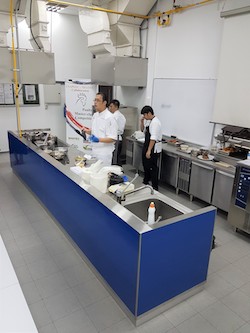 |
Chef Elvin Chew conducting the first Master Class |
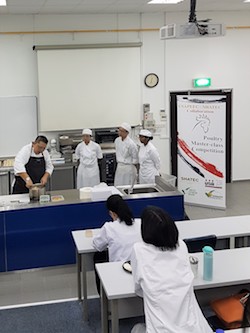 |
Chef Eric Low conducting the second Master Class |
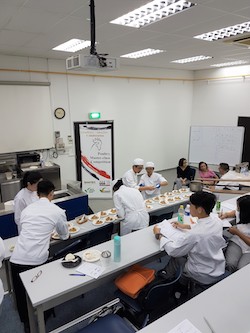 |
Sampling of dishes prepared at Master Class |
| |
|
|
|
 |
|
Poultry cooking workshop in Vagabond Hotel USAPEEC and Xin Flavors Magazine collaborated in organizing a U.S. poultry cooking workshop held on August 26, 2017 in Vagabond Hotel for a group of 35 working adults as well as home makers who are readers or subscribers of the Xin Flavors Magazine.
The event provided a unique experience of a poultry cooking demonstration and workshop using three specially created recipes by well-known local Chef Aaron Tan. The dishes presented included butter curry crispy chicken, shredded chicken with Sichuan sauce and steamed minced chicken with salted egg yolk and preserved mustard. The participants were provided with a step-by-step explanation on the preparation of each of the three dishes using U.S. frozen chicken parts as the main ingredient.
At the start of the cooking workshop, Margaret Say, USAPEEC ASEAN Director, gave a short brief about the nutritional qualities of U.S. poultry. From an analysis of the participant responses at the end of the event, 87 per cent of the participants were more aware of U.S. poultry products after the workshop while 90 per cent of the participants acknowledged that they were more aware of the nutritional qualities and high food safety standards of U.S. poultry. |
|
Margaret Say welcomes participants to poultry cooking workshop at Vagabond Hotel |
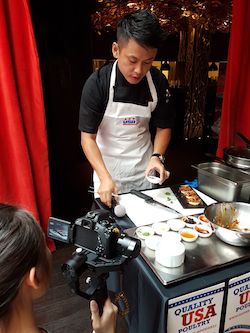 |
Chef Aaron Tan demonstrating the finer points of preparing chicken dishes |
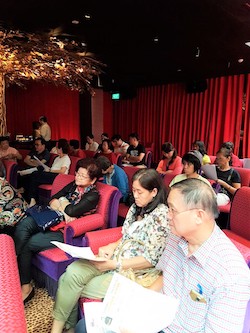 |
Participants listening intently to poultry cooking workshop at Vagabond Hotel |
| |
|
|
|
|
|
News Bites
Consumer Markets
Cambodia
Tim Ho Wan debuts in Cambodia
Tim Ho Wan, a famous Hong Kong-based dim sum chain and Michelin award winner, opened its first branch in Cambodia in August. The general manager of the Cambodian outlet said the restaurant drew some 700 customers a day during the five-day soft opening. He added that there are plans to open two more branches in Phnom Penh next year.
Malaysia
4Fingers to open 20 outlets in five years
4Fingers, a Singaporean fried chicken fast food chain, is looking to open 20 outlets in Malaysia over the next five years. The company recently launched its fourth store in Malaysia and is exploring the commencement of a delivery service for its customers.
Myanmar
Kachin State to see first ski resort
The Minister of Hotel and Tourism, U Ohn Maung, said a new ski resort will be constructed at the Khakaborai. Khakaborazi is located in the Naungmung township in Kachin, a northern state of Myanmar. At 5,881 meters above sea level, it is possibly one of the highest mountains in Southeast Asia. The ski resort project is part of the ministry’s long-term plan to diversify domestic tourism offerings and develop eco-tourism in Myanmar.
Philippines
Macau Galaxy Casino betting on the Philippines gaming market
Macau-based Galaxy Casino is partnering with Alfredo Benitez, founder of Leisure and Resorts World Corp. (LRWC), to build an integrated casino resort in the Philippines. The joint venture is expected to invest US$300 to US$500 million into the project. The site for the casino resort has not been determined.
Vietnam
HCM City’s first street food zone opens for business
Ho Chi Minh City opened its first street food zone in District 1 as part of the district’s efforts to clean up its sidewalks. The nation’s first street food zone stretches 40 meters on the sidewalk of Nguyen Van Chiem. The vendors are permitted to operate from 6am to 9am and 11am to 2pm. This first zone on Nguyen Van Chiem Street has been designated for low-income vendors. They will not be required to pay a fee to sell their goods in that zone. Each of the 20 stalls takes up only a third of the sidewalk, giving pedestrians enough room to move around. The city's second street food zone is expected to open at Bach Tung Diep Park within a month.
Central Group to pour B17 billion into Vietnam operations
Central Group of Companies, a leading retail and property developer in Thailand, will be investing B17 billion (US$513 million) to expand its operations in Vietnam over the next five years. Chief executive of Central Group Vietnam, Philippe Broianigo, said the budget will be used to expand all businesses the group has set up in Vietnam, with special focus on food and electronics. The group has allocated B7 billion (US$211 million) to open 20 Big C supermarkets. There are also plans to open 30 new branches of the Nguyen Kim electronics chain. Central Group said it is aiming for annual growth of 20 to 30 per cent in Vietnam. |
|
|
| |
|
| |
|
|
|
| |
|
Regulatory changes impacting consumer foods
Philippines
The Philippines suspends guideline which impacts U.S. poultry imports
The Philippines government has suspended Circular No.14 which had intended to impose restriction to only one plant in each application for SPS Import Clearance for meat and poultry imports into the country. The restriction to only one foreign meat establishment for each SPS import application will create difficulties for both U.S. exporters and Philippine importers as most shipments originate from multiple plants. At the time of reporting, it is not clear as to how long the suspension of Circular No. 14 would last.
Singapore
Singapore major soft drinks manufacturers agree to reduce sugar content in soft drinks
Singapore major soft drinks manufacturers agree to reduce sugar content in soft drinks
The Singapore Ministry of Health (MOH) announced on August 21 that seven major soft drinks manufacturers have agreed to reduce the sugar content in all their drinks in Singapore to 12 per cent and below by 2020. The seven major manufacturers make up 70 per cent of the total pre-packaged sugar sweetened beverage market in Singapore. MOH stated that the 60 per cent of the total sugar intake comes from sugary beverages including soft drinks, juices, coffees, and teas. It is anticipated that the above measures will help to reduce the incidence of diabetes in the Singapore population. Currently MOH estimates that one out of three Singaporeans will have a lifetime risk of getting diabetes.
| |
| |
|
|
|
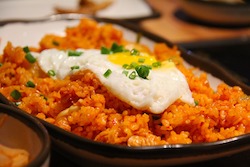 |
|
The surge of Halal tourism
The hospitality and tourism industry has observed the rise in Halal tourism in recent times1. Muslim travelers form a diverse untapped business market for suppliers of services and restaurateurs to explore. As Muslims can only consume food that is Halal, restaurateurs constantly explore other permissible options in order to attract them to dine at their outlets. Currently, Halal tourism is forecasted to generate US$238 billion by 20193. Travel websites from Japan, Korea and Hong Kong offer extensive guides to halal dining while the Tourism Authority of Thailand created an app to target the Muslim market in 20162. Back in 2014, the Halal industry in Malaysia accounted for approximately US$8 billion4. This reveals that there are plenty of business opportunities for restaurateurs to consider exploring.
In Singapore, numerous popular chains have obtained the Halal license to serve dishes that can be consumed by Muslims. For example, FatPapas is a Halal version of the widely loved non-Halal burger joint, Fat Boys’ Burger5. This Halal burger café serves beef and chicken patties made of Halal meat and other scrumptious poultry dishes to attract the Muslim community. Hip Korean chain, Mukshidonna, known for its delectable serving of ‘army stew’ dish, has recently acquired the Halal certificate to cater to these diners6. Their menu includes Halal ingredients such as chicken sausages, chicken ham, chicken dumplings and chicken broth. Restaurants are making such moves to cater to the more than 800,000 Muslims who currently reside in Singapore7. Several major western fast food chains in Singapore including McDonald’s, KFC, Burger King, Texas Chicken, Pizza Hut and Swensen’s have had their restaurants certified Halal for a number of years already. This allowed them to utilize common kitchen equipment, cold storage facilities and backroom procurement to cater for all market segments.
Taiwan is home to over 170,000 Muslims who came from North-Western regions in China7. In 2015, Taiwan’s Tourism Bureau shared that there were over 200,000 Muslim travelers that visited Taiwan8. Within Taipei alone, there are countless of Halal-dining options that serve tasty local dishes to the masses. Some of these dishes include beef noodle soup, chicken and vegetarian dumpling noodles, skewered chicken and duck meat, fried chicken meals and more8.
Based on the expanding Halal customer population, Halal food and tourism is a bourgeoning market not to be neglected2.
References
1. The Guardian. (2017). Halal tourism: Kuala Lumpur welcomes the Muslim travellers others didn't want. [online] Available at: https://www.theguardian.com/cities/2017/jun/06/halal-tourism-kuala-lumpur-muslim-travellers-malaysia
2. Khaleej Times. (2017). The growing popularity of halal tourism. [online] Available at: http://www.khaleejtimes.com/business/local/the-growing-popularity-of-halal-tourism
3. The Straits Times. (2016). Islamic tourism: The next big thing? [online] Available at: http://www.straitstimes.com/opinion/islamic-tourism-the-next-big-thing
4. TODAYonline. (2014). Malaysian halal food companies primed to feed Muslims' taste for travel. [online] Available at: http://www.todayonline.com/business/malaysian-halal-food-companies-primed-feed-muslims-taste-travel
5. Seth Lui. (2017). FatPapas: Don’t Miss Out On This Halal Burger Joint’s Special Ramadan ‘R&B Burger’ & Massive Dishes At Bali Lane. [online] Available at: http://sethlui.com/fatpapas-halal-burger-singapore/#ixzz4rX86bz4x
6. Mothership. (2017). Famous Korean restaurant chain Mukshidonna in S’pore is now Halal-certified. [online] Available at: https://mothership.sg/2017/08/famous-korean-restaurant-chain-mukshidonna-in-spore-is-now-halal-certified/
7. TODAYonline. (2017). Singapore’s Haj quota raised to 800 as Muslim population increases. [online] Available at: http://www.todayonline.com/singapore/singapores-haj-quota-raised-800-muslim-population-increases
8. Channel NewsAsia. (2016) Taiwan For The Travelling Muslim. [online] Available at: http://www.channelnewsasia.com/news/theasiantraveller/articles/taiwan-for-the-travelling-muslim-7686188 |
|
Halal Korean fried rice dish served in a Korean restaurant in Singapore |
| |
|
|
|
 |
|
Meet the cashless society in Singapore
The Monetary Authority of Singapore (MAS), Singapore’s central bank, will be developing a universal QR code payment system for island-wide usage by end of year1. This aligns with the Singapore government’s efforts to push the country towards Smart Nation and a cashless society2. QR refers to a quick-response code which comes in a squared barcode. It is used to scan a wide variety of data into smartphones3.
The Singapore government is advocating the implementation of QR code to promote the convenience of cashless transactions between merchants and consumer3. They recognize the demand for quick payment services due to the growing adoption of e-payments in the country. For instance, DBS Bank encourages small-scale cash-based merchants such as hawker centers to embrace QR codes as a mode of payment3. Patrons can purchase their favorite local dishes such as chicken rice, chicken dumpling noodles and roasted duck rice by simply scanning the barcode in the app. Since its debut back in April, DBS Bank has facilitated over 15,000 QR code scans with the number of such transactions expected to increase3.
Despite the push for cashless payments, some merchants believe that physical cash dominates4. According to a study conducted by an online payment service provider PayPal, 90 per cent of 500 consumers revealed that they prefer transacting with cash2. Small-scale cash-based merchants voiced their concerns regarding the fee they will incur in order to adopt e-payments at hawker centres.
Despite some challenges, a DBS Bank spokesperson recently shared that over 1,000 merchants are adopting the cashless payment system and majority of these merchants are hawker stall owners4. The DBS Paylah app is free for merchants to implement and there are no additional costs incurred for transactions that are made through the app4. DBS hopes to encourage hawker stall owners to adopt the e-payment system by reducing the barrier to entry and adoption. By venturing into the new market of a cashless society, hawker stall owners can tap on a new pool of customers who prefer to transact via e-payments4.
Another example of increasing cashless payment adoption is from a trendy hawker centre at Pasir Ris was recently launched. It is designed to provide the best dining experience for diners and support hawker stalls in their daily operations. All transactions made in this hawker centre will be cashless5. Singapore authorities plan to expand cashless payment method to 30 hawker centres by end of 2017. It is estimated that about S$1 billion in cash based payments are transacted across 6,000 hawkers and food stalls in Singapore annually. With such measures in place, Singapore definitely seems to be heading towards being a cashless-first society.
References
1. The Business Times. (2017). Singapore looks into common QR code for cashless payments. [online] Available at: http://www.businesstimes.com.sg/government-economy/singapore-looks-into-common-qr-code-for-cashless-payments
2. SGSME. (2017). Singapore looks into common QR code for cashless payments. [online] Available at: http://www.sgsme.sg/news/singapore-looks-common-qr-code-cashless-payments
3. The Straits Times (2017). Common QR code for cashless payments in Singapore may be ready by year's end. [online] Available at: http://www.straitstimes.com/business/banking/task-force-set-up-to-create-common-qr-code-for-e-payments-in-singapore
4. The New Paper. (2017). For businesses in Singapore, cash is still king. [online] Available at: http://www.tnp.sg/news/singapore/businesses-singapore-cash-still-king
5. Yahoo! Lifestyle Singapore. (2017). Street food, 'hipster kitchens' and no cash at Pasir Ris' first hawker centre. [online] Available at: https://sg.style.yahoo.com/street-food-hipster-kitchens-no-cash-pasir-ris-first-hawker-centre-095034003.html |
|
A standard scan of a QR code |
| |
|
|
|
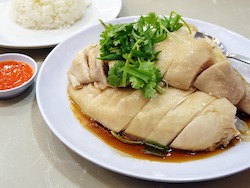 |
|
Healthy eating at hawker centres
As the adage goes, “When in Rome, do as the Romans do”. In Singapore, one must dine at a hawker centre to truly experience the authenticity of local fare. A hawker centre is an open-spaced food complex that serves a plethora of inexpensive local dishes. An average meal costs approximately US$2.60.
According to the Health Promotion Board in Singapore, one third of Singaporeans consume food out of homes more than seven times a week1. 80 per cent of them purchase their meals from hawker centres more than once a week1. Previously, the food served in hawker centres were notoriously known to be greasy with saturated unhealthy oils and high in sodium content2. However, there have been massive changes implemented by the Singapore government to encourage hawker centres to serve healthier options that are less oily, lower in salt content and offer more vegetables to consumers. The Health Promotion Board aims to get forty per cent of hawker stalls to serve at least one healthier dish by 20192. To date, there are an estimated 13,000 hawker stalls across Singapore3.
Mee soto, one of Singaporeans’ favorite hawker dishes, has a light chicken broth, topped with noodles, shredded boiled chicken, beansprouts and chopped chives4. It clocks in less than 500 calories with a relatively low fat content. Chicken dumpling noodles are also considered healthy when the dumplings are steamed instead of fried3. A plate of chicken rice can be consumed healthily when the consumers opt for steamed chicken without fatty skin. By ordering the meal in this manner, diners trim down at least two grams of fat6.
The Health Promotion Board conducts frequent checks to ensure hawker stalls serve quality and healthy meals to consumers. For those who meet such standards, they will be awarded with a label to educate consumers that the stalls serve healthy meals below 500 calories3. This initiative by the government is part of the Healthier Dining Program, covering over 2,700 outlets in 60 hawker centres and 450 coffee shops island-wide3. Through this initiative, hawker stalls put in effort to provide healthier options to diners to obtain this label. Such measures include offering more vegetables without additional costs, steamed chicken instead of fried, wholegrain breads, brown rice and more6.
As such, diners can now consume their meals at ease knowing that they can dine healthily at the humble hawker centers without needing to burn a hole in their wallets.
References:
1. Health Promotion Board. (2016). Making street food healthier in Singapore. [online] Available at: http://www.wpro.who.int/noncommunicable_diseases/about
/HealthierFoodCentreProgramme-Singapore.pdf
2. The New Paper. (2017). Eating healthier at hawker centres. [online] Available at: http://www.tnp.sg/lifestyle/makan/eating-healthier-hawker-centres
3. The Straits Times. (2017). HPB serves up plan for healthier hawker food option. [online] Available at: http://www.straitstimes.com/singapore/health/hpb-serves-up-plan-for-healthier-hawker-food-option
4. Health Hub. (2017). Eating light at a hawker centre is possible. [online] Available at: https://www.healthhub.sg/live-healthy/1463/eating-light-at-a-hawker-centre-is-possible#footnotes
5. Health Hub. (2017). Healthy hawker hacks. [online] Available at: https://www.healthhub.sg/programmes/86/healthy-hawker-hacks
6. The Straits Times. (2017). How to eat healthier at hawker centres. [online] Available at: http://www.straitstimes.com/lifestyle/food/how-to-eat-healthier-at-hawker-centres
|
|
A chicken rice meal served in a hawker centre |
| |
|
|
|
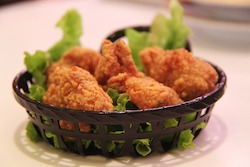 |
|
Finger lickin' good chicken dishes in Asia
The earliest documented recipe for American fried chicken was published in a British cookbook in 1747. Consumers associated fried chicken with South America as the locals there were the first to introduce this dish in the 18th century1.
The traditional American fried chicken is still widely consumed till today. Tsung Ting Wang, a renowned chef from New York City, invented his famous General Tso’s chicken, a Chinese-influenced dish with a unique twist from the classic American fried chicken. The dish created comprises of sweet and saucy chicken nuggets.
In Asia, there are various delicious fried chicken dishes available. We walk through some of the recipes. Notable differences between an American and Asian fried chicken dish is the incorporation of various spices, herbs, marinades, and accompanying dips3.
Singapore’s Har Cheong Gai
Har cheong gai, also known as prawn paste chicken, is a popular Singaporean dish. It involves marinating chicken parts in prawn paste before deep frying them to achieve a crunchy exterior. Prawn paste is made from fermented silver shrimps that are commonly used in Southeast Asian dishes. It has a distinctive aroma and is often used in a small amount as seasonings and marinades4. Har cheong gai is regarded as the epitome of fried chicken wings in Singapore due to its plump, juicy interior and thin yet crispy exterior5. It is a common dish usually eaten at zi char stalls where the chefs provide a variety of comforting Chinese home-style dishes for communal dining. Such stalls are often found in local eateries and coffee shops6.
Indonesia’s Ayam Penyet
Ayam penyet is an Indonesian dish that consists of “smashed” fried chicken, served with rice, sambal (spicy chilli dip), cucumbers, fried tofu (beancurd), and tempeh (soybean cake). The chicken is flattened with a pestle or tenderizer for a soft texture7. The spicy sambal is made with a mixture of chilli, anchovies, tomatoes, onions, garlic, belacan, assam, and lime juice to produce a paste8. Ayam penyet dishes are popular across Asia and have resulted in many franchising opportunities throughout the region8.
Taiwan’s Ji Pai
Taiwanese ji pai are large pieces of pounded fried chicken breast fillets. They are a popular street food snack at Taiwanese night markets9. The marinade is a mixture of sugar, soy sauce, garlic, rice wine, and spices. The batter is a coat of beaten eggs and flour or sweet potato starch, resulting in crispy exterior after frying. The ji pai is seasoned again before serving piping hot10. Due to the popularity of Taiwanese snacks, Hot-Star Large Fried Chicken, a famous chain in Taiwan, expanded its operations to countries including the Philippines, Indonesia, Australia, Canada and the United States11.
Thailand’s Gai Tod
Gai tod is Thailand’s version of fried chicken that is sold across all street vendors in Thailand. It is served with steamed or sticky rice to balance out gai tod’s bold flavors. The chicken gets its intense flavors from its marinade of coriander seeds, fish sauce, cilantro, cumin, white pepper, shallots, garlic, and coconut milk. It is best served with a garnish of Thai basil and sweet chili sauce12.
References
1. First We Feast (2016). An Illustrated History of Fried Chicken in America [Online] Available at: http://firstwefeast.com/features/2016/04/fried-chicken-illustrated-history
2. Smithsonian Magazine (2016). A Brief History of General Tso’s Chicken [Online] Available at: http://www.smithsonianmag.com/smart-news/general-tsos-chicken-got-its-start-fine-dining-180956795/
3. Chicago Tribune (2013). Marinades and sauces transform fried chicken [Online] Available at: http://articles.chicagotribune.com/2013-04-10/features/sc-food-0405-asian-fried-chicken-20130410_1_chicken-kimchi-chronicles-harland-sanders
4. Foodelicacy (2016). Prawn Paste Chicken A.K.A Har Cheong Gai (虾酱鸡) [Online] Available at: http://foodelicacy.com/prawn-paste-chicken/
5. ieatishootipost (2014). Prawn Paste Chicken (Har Cheong Gai) Recipe: The Zi Char Version [Online] Available at: http://ieatishootipost.sg/prawn-paste-chicken-har-cheong-gai-recipe-the-cze-char-version/
6. Ladyironchef (2016) A GUIDE TO ZI CHAR – 21 POPULAR ZI CHAR DISHES EVERYONE SHOULD KNOW ABOUT [Online] Available at: http://www.ladyironchef.com/2016/05/zi-char-guide/#more-84037
7. Honeycombers (2016). BEST AYAM PENYET IN SINGAPORE: RESTAURANTS AND STALLS THAT SERVE THE INDONESIAN SMASHED FRIED CHICKEN WITH RICE DISH [Online] Available at: http://thehoneycombers.com/singapore/best-ayam-penyet-in-singapore-restaurants-and-stalls-that-serve-the-indonesian-smashed-fried-chicken-with-rice-dish/
8. The Best Ayam Penyet In Brunei (2013). HISTORY AYAM PENYET [Online] Available at: http://zaeeem218.blogspot.sg/2013/11/history-ayam-penyet.html
9. Tara's Multicultural Table (2016). JI PAI (TAIWANESE FRIED CHICKEN STEAK) [Online] Available at: http://tarasmulticulturaltable.com/ji-pai-taiwanese-fried-chicken-steak/
10. BootsnAll (2016). Eat Your Way Around Taiwan [Online] Available at: http://www.bootsnall.com/articles/13-06/food-in-taiwan.html
11. HotStar (2017). Store [Online] Available at: http://www.hotstar.com.tw/EN/Retail/ugC_Retail.asp#Pagecontent
12. Paste Magazine (2015). 5 Asian Fried Chicken Styles That Give The South a Run for Its Money [Online] Available at: https://www.pastemagazine.com/articles/2015/07/5-asian-fried-chicken-styles-that-give-the-south-a.html
|
|
Thai-style fried chicken dish |
| |
|
|
|
|
Disclaimer: All opinions and views expressed in the articles published in the newsletter are those of the individual journalists and do not necessarily reflect those of the publisher, the newsletter's sponsors or USA Poultry & Egg Export Council.
You have received this email because you have registered to get newsletters from USAPEEC ASEAN.
If you prefer not to receive these updates, please
click here
to unsubscribe.
Do not reply to this email. For enquiries, go to www.usapeecasean.com
® USA POULTRY & EGG EXPORT COUNCIL
541 Orchard Road, #15-04, Liat Towers, Singapore 238881 Tel: (65) 67371726 Fax: (65) 67371727
*|REWARDS|* |
|
|
|